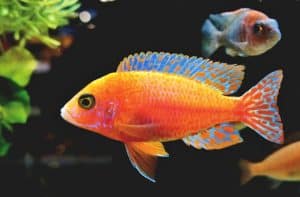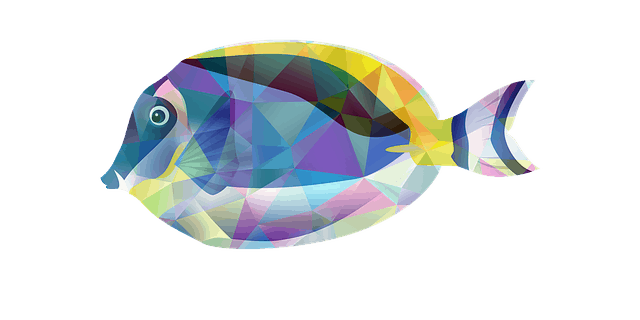If you have taken the plunge into raising fish or having an at home aquarium you probably have hundreds of questions. Especially for all the new fish owners reading out there. I get it. I was the same way and learning what to look for and how to raise fish isn’t the most straightforward task.
Especially in the beginning. Whether you’re trying to determine the correct ways to raise a fish or even how to keep the water clean and balanced is a challenge of its own. That’s not all either. Not too long ago, I had a new question pop up that I was curious to learn and find out more about. One of my fish began showing signs of a bulge in the belly, and I got to wondering. Is my fish pregnant? If she is, how can I tell and what should I do? Here’s what I’ve learned.
So, is my fish pregnant? If your fish is pregnant, you should have witnessed some signs of mating rituals taking place. If you missed it, you could distinguish a pregnant fish by the bulge in the belly (back of the abdomen). It will continue to grow over the course of 20-40 days and creep closer to the lower gills.
Now, that may have answered your question about 1 sign to look for, but other factors are involved, and you should know some additional information about recognizing fish pregnancy and what else that entails.
Let’s dive into some of the details even further including some ways to distinguish if you are staring at a male or female fish.
Understanding Your Fish and What to Look For- Males Versus Females
Male Fish and How to Tell
Before having any chance at recognizing if your fish is pregnant or not, it’s best practice to understand which of your fish are the males and which are the females. Not understanding this will lead to some confusion. To identify the difference, you can follow a few simple rules to gain an understanding of the differences. First, the male fish is almost always brighter and embodies deeper colors. A male fish also has a narrow long anal fin.
The anal fin will be located on their lower side near the tail.
Female Fish and How to Tell
On the flip side, you have the female fish that you need the ability to recognize. The female fish will have a triangle shaped or “fan-shaped” anal fin. This fan-shaped fin is also located on the underbelly/abdomen on the run heading towards the tail. These are the key characteristics to look for when distinguishing the differences between the two.
Now that we know the differences between the two fish we need to touch on behaviors and actions that could indicate your fish is pregnant. It won’t always be this simple to distinguish the two fish. Some species of fish are harder to notice the differences. If you run into this issue, ask an expert at the aquarium store for some guidance.
Common Symptoms to Watch For- Telling Signs Your Fish Is Pregnant
Remember, it always takes two to make some fish babies. This means that you can learn and begin watching for mating rituals that fish will go through before the female fish would reach a stage of being visually pregnant. All fish will have different routines for mating, and they can vary greatly. You need to take the time to learn about the fish species you are breeding in your aquarium. We talk about this in our article about raising fish and ethical concerns in doing so. You can see that here.
Playing Hard to Get- A Common Mating Ritual in Many Fish Species
One familiar mating ritual you can watch for is to look for your male fish to be consistently chasing the female fish around energetically like a teenage boy. Sometimes, this can get a bit messy. They may even be causing bites, scrapes and other physical damage to each other. It’s okay. If it doesn’t appear to be getting out of control, then it’s just a part of the game these fish like to play during the mating process.
Other fish, you may notice “hanging out” and acting like they are guarding one area of the tank like it’s Fort Knox. This is another tall tale sign that mating rituals are taking place with your fish. Regardless of which of these you witness, there’s a strong chance that it’s time to start watching for physical signs in your female fish that she is now indeed, pregnant.
Momma Fish Is Looking A Bit “Chunky”
All though we have already touched on this, I wanted to recap again just to be very clear about what to look for. Your female fish, if pregnant is going to start showing the baby bulge at this point. It will be in the back portion of the abdomen.
Don’t Confuse This with The Over Eating, Fat Male Fish- It’s Time for A Diet
Be careful, you may have an issue telling the difference if you have a male fish with an over-eating problem. Refer to our methods of distinguishing the fins to be sure. You can also remove food from fat man’s diet for a day or two to be 100% sure and watch for the male’s bulge to begin shrinking during this period. A female bulge, however, will not shrink. It will only grow if she is pregnant.
On a female fish, you can also look for red or black spot indicating pregnancy. This is known as the “gravid spot” on the belly/ abdomen. During the pregnancy, it will be even easier to see this bulge over time as it grows brighter and more pronounced over time.

Well Darn, My Fish Is Pregnant. What Do I Need to Do Now?
Alright, so we know for sure that your fish is pregnant. We have no doubt, and we know she is going to pop one of these upcoming days (not literally). Now what? Well now, you need to prepare for some young baby fish also known as fry. This is no easy task so be prepared.
First, you are going to need an entirely different tank. This helps eliminate the chance of the water filter hurting the young fish. You can always contact an aquarium store and explain the situation as well. They will break down what to expect and what’s coming soon. They should also walk you through the most logical step to take next. Again, you need to learn about your specific fish to know what to do in these situations.
In many situations, you will need to replace your filter with a sponge filter if you won’t be using a separate tank or if the separate tank is running a normal filter currently. A regular filter may suck those young fish in and kill them. You will most likely also need to purchase liquid food to ensure your fry have something to eat.
Now, Figure It Out on Your Own for Your Specific Fish Breed.
Outside of these common tactics to use to care for the young fry, it’s on you to figure out the rest based on your specific fish species. Learn the fish you raise inside and out, and the fear and anxiety of having some newborn fish should begin to subside, and you should even be feeling somewhat excited for the challenge.
Now, just to add the icing on the cake for you, we wanted to break down a few more facts about fish pregnancy that may have you more readily prepared for what’s looming around the corner.
Here’s a breakdown of some of the common fish pregnancy durations and when you can expect those eggs to hatch.
How Long Is Fish Pregnancy? What Can I Expect? 3 Fish Species Broken Down
So, without further ado, here are some of your common durations for fish pregnancies.
How Long Is A Guppy Fish Pregnant?
A guppy fish will have a gestation period ranging from 21-30 days. 22-26 days is the most common range and when most guppy pregnancies will be complete. Also note, the higher the water temperature in your aquarium, the better. This prevents your female guppy from remaining pregnant for too long.
How Long Is A Goldfish Pregnant?
A goldfish will remain pregnant for a grand total of ZERO days. Goldfish don’t carry eggs like other fish. Goldfish spray eggs and the male goldfish fertilized them. The eggs will then attach to any surface and hatch within 2-7 days although 46-54 hours is the universal ideal length before hatching in the correct water temperatures.
How Long Is A Koi Fish Pregnant?
A Koi fish uses the same approach as the goldfish for having babies or laying eggs. This means that koi fish are not livebearers. They release eggs over three-day period. This is known as spawning, and the male will come by to fertilize these eggs. What a gentleman.
Putting It All Together- Understand Your Fish and Provide A Stable Environment
To sum things up, understanding your fish as much as possible always goes a long way. It will help you distinguish if your fish are pregnant and help prepare you for the fry (fish babies) that will soon arrive. Anytime you are trying to recognize if a fish is pregnant and still are lost and confused about what to do, you should always speak to a professional to gain some guidance on the matter.
Best of luck with all your fish pregnancies!




